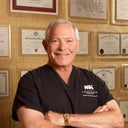Face lift surgery refers to cosmetic surgery of the lower 2/3 of the face, which involves the area in-front of the ear, along the jawline, and the upper neck to improve the neck line or "turkey neck". Face lift surgery is commonly combined with a neck lift or submental liposuction. Face lift surgery may be performed via several types, such as SMAS lift, MACS lift, mini lift, deep plane face lift, etc.










